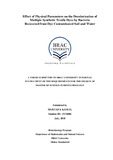Effect of physical parameters on the decolorization of multiple synthetic textile dyes by bacteria recovered from dye contaminated soil and water
Abstract
Textile wastewater is a complex mixture of many contaminating materials. These
include a high concentration of salts, acids, heavy metals, organochlorine-based
pesticides, pigments, dyes etc. Dye is the first pollutant to be recognized in wastewater
and many synthetic dyes are toxic, mutagenic and carcinogenic in nature. This makes
dyes imperative to be removed from textile wastewater. Current physicochemical textile
dye removal methods are less efficient and expensive. Bioremediation through
utilization of synthetic dye degrading bacteria can be considered as an effective aid to
the clean-up process. The present study attempts to decolorize eight synthetic textile
dyes: Novacron Brilliant Blue C-B, Novacron Dark Blue S-GL, Novacron Navy S-GI,
Novacron Turquoise GN, Novacron Super Black-G, Novacron Ruby S-3B, Avitera
Brilliant Yellow SE and Novacron Yellow S-3R by newly isolated bacterial strains
from dye contaminated soil and water. Dye decolorizing ability of bacteria was
screened on Nutrient broth containing mixed dyes. Effects of different physical
parameters like dye concentration, temperature, pH, agitation and seed culture
concentration on the dye degrading ability of selected isolates were tested. The potential
isolates were selected for BiOLOG identification. Pseudomonas aeruginosa (S9A6) exhibited to be the most promising amongst the isolated bacteria for decolorizing synthetic
dyes, followed by Bacillus cereus/thuringiensis (S1A6). Pseudomonas aeruginosa was
tested further for effects of mixed dye concentration and the repeated addition of dye
aliquots up to four cycles. The decolorization obtained in this study was expressed in
percentages with Pseudomonas aeruginosa, S9A6 having up to 98.5% decolorization
of Novacron Super Black-G, 98.4% of Novacron Yellow S-3R, 98.3% of Novacron
Dark Blue S-GL, 97.4% of Novacron Navy S-GI, 96.7% of Novacron Ruby S-3B,
94.2% of Novacron Brilliant Blue C-B and 88.6% decolorization of six synthetic dye
mixture for 100 ppm of dye concentration when incubated under stationary condition
at 37°C for 72 hours. However, there was no observable color difference for Novacron
Turquoise GN and Avitera Brilliant Yellow SE by any of the isolated bacteria. The
prime candidate Pseudomonas aeruginosa also exhibited very good ability to
decolorize repeated additions for six individual dyes up to the fourth cycle without
supplementation of additional nutrients, which is remarkable criteria for commercial
applicability of it in textile effluent treatment.

